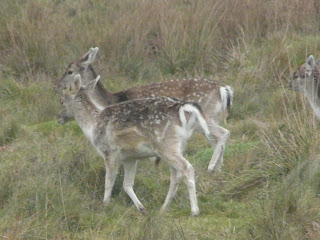The Dorset Wildlife Trust produced an excellent book in 2012 about the 'Great Trees of Dorset' which Andrew Pollard and Emma Brawn, who were working on the Greentree Project, authored. The book points out that there have been sixty-four deer parks in Dorset over the years and these were mainly grazed by fallow deer (Dama dama). These deer parks were very expensive to maintain and have largely died out and now just three remain, at Melbury, Sherborne Park and Stock Gayland (near Bishops Caundle) where I was able to get this photo from the road over looking the park. If you see wild deer in Dorset they are unlikely to be fallow, more likely to be roe (or, in Purbeck, sika).
Fallow deer are relatively small, have the familiar white rear and have white spots. Take care with the white spots, younger roe and sika also have them but, in general, if you see a herd of deer and they all have spots they will be fallow deer .
It is uncertain whether fallow deer were brought to Britain by the Romans or the Normans although popular opinion now seem to rest with the Normans who brought them over for hunting and food, just as they did rabbits. The Normans where more 'in to' country estates and hunting than the Romans which seems to lead us to the conclusion that they were behind it.
Sadly, at the time I photographed these, the bucks had lost their unique 'bladed' antlers, I will really have to return and see if I can get a male with a full set ready for action in the rut in the autumn.

Comments
Post a Comment